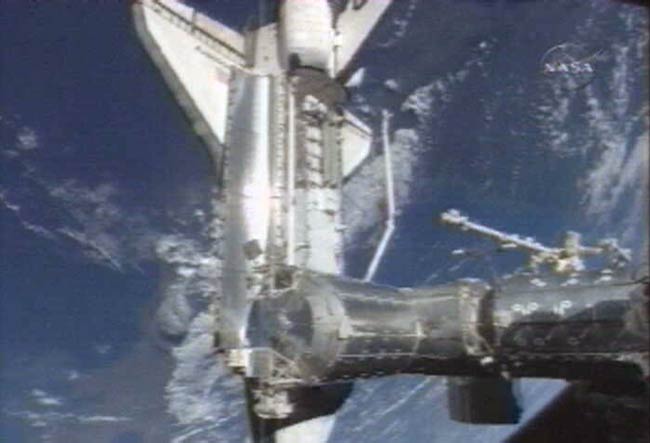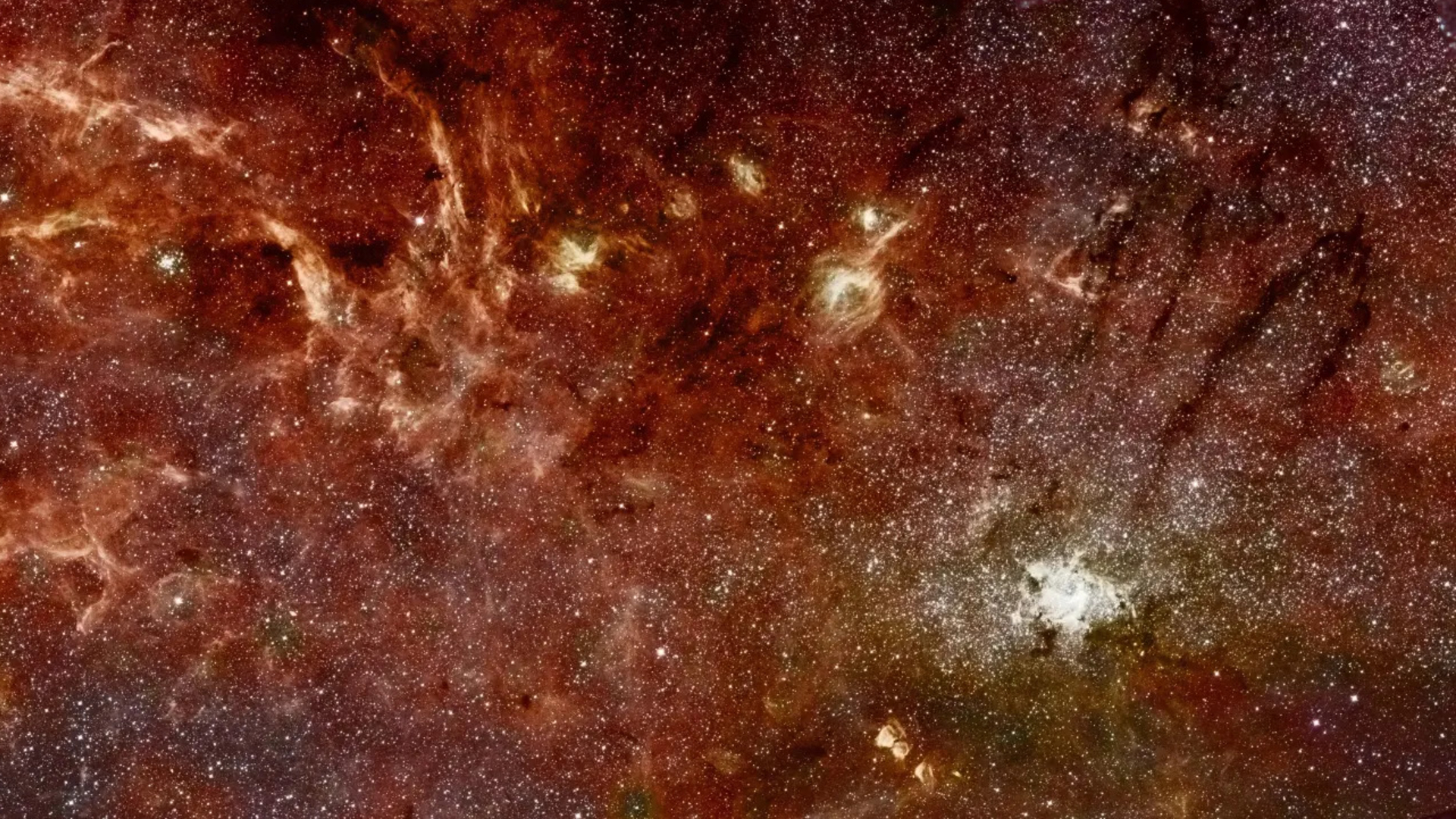Space Station Dodges More Debris

This story was updated at 8:27 p.m. EDT.
TheInternational Space Station dodged a small piece of space junk Sunday leftoverfrom a spent Chinese rocket that broke apart in orbit nine years ago.
MissionControl radioed the crew of the space shuttle Discovery, which is dockedat the station, to perform a small thruster maneuver that changed theorientation of the space station, slowing it slightly and putting moreclearance between the $100 billion orbiting laboratory and approaching spacejunk, NASA officials said.
NASAofficials said the chunkof orbital debris is a small 4-inch (10-cm) piece of a Chinese satellite rocketstage that launched in 1999 and broke apart in March 2000.
Spacestation flight director Kwatsi Alibaruho said the space trash was going to flynear the space station up to twice each orbit, the first time occurring Mondayabout two hours into a spacewalk by astronauts. NASA traditionally does notmake orbital adjustments while astronauts are outside the station because ofthe high forces the maneuvers put on the structure.
?Because ofour concerns about having to take action during a spacewalk, we preemptively adjustedthe orbit of the International Space Station and the space shuttle,? Alibaruhotold reporters late Sunday.
Discoverycommander Lee Archambaultfired the shuttle?s thrusters at about 4:00 p.m. EDT (2000 GMT) in a half-hour maneuverto change the station?s position as it flies through space. The orientationplaces the shuttle in front of the station and is the same that will be usedwhen Discovery undocks on Wednesday. It should slow the station by about 0.1feet per second due to atmospheric drag, NASA officials said.
Breaking space news, the latest updates on rocket launches, skywatching events and more!
?Overseveral hours, this will lower the orbit very slightly, enough to avoid a pieceof orbital debris whose erratic orbit makes it a potential threat,? NASAofficials said.
NASAand its space station partners typically move the 1 million-pound (453,592 kg)orbiting lab when a piece of debris is expected to fly within an imaginary boxthat extends 15 miles (24 km) to either side of the outpost, which is longerthan a football field.
?Spacedebris is becoming an ever-increasing challenge,? Alibaruho said. ?We?ve beenvery fortunate, and also very diligent, about monitoring space debris.?
Space debris traffic
TheChinese debris is the thirdpiece of space junk to fly near the space station in two weeks. Missionmanagers have said that while there seems to be recent uptick in space debris,the events can ebb and flow like freeway traffic on Earth.
?Ithink these types of things will come and go in seasons,? Alibaruho said. ?Rightnow, we?re going through a season where we?ve had a number of things that we?vehad to dodge.?
OnMarch 17, the remains of a Soviet-era military navigation satellite promptedflew past the space station just before Discovery docked at the orbitinglaboratory. That debris was a small piece of the defunct Cosmos 1275 satellite,but it zoomed past the space station at a far enough distance that no avoidancemaneuver was required.
Thatwas not the case for another piece of space trash that buzzed the space stationon March 12. That debris, a 5-inches (13-cm) wide piece of spent satelliterocket motor, flew within 2.4 miles (4 km) of the space station at a clip ofabout 19,800 mph (31,865 kph). The space station orbits the Earth at about17,500 mph (28,163 kph).
Noticeof the March 12 debris event came too late for flight controllers to move thespace station. Instead, station commander Michael Fincke and his two crewmates hadto take shelter in their Russian-built Soyuz spacecraft, which doubles as alifeboat and ferry to and from the orbital laboratory.
Spacedebris has been a growing threat for the International Space Station and othersatellites in orbit. On Feb. 10, an outdated Russian satellite collided with aU.S. communications satellite in anunprecedented crash that created two large clouds of debris.
NASAsaid the collision increased the risk of a debris strike during a space shuttlemission to the station by about 6 percent, or a 1-in-318 chance.
?There?s alot of debris out there,? Fincke said in a televised interview on Friday,adding that space trash poses a risk to astronauts in space as well as thesatellites that aid life on Earth. ?We need to be able to truly have a way todispose of our satellite when we?re finished with them.?
Discovery?sseven-astronaut crew had a half-day off at the space station Sunday morning asthe spaceflyers prepare for their third and last spacewalk on Monday. Theshuttle has passed the midpoint of its 13-day mission to replace a stationcrewmember and deliver the outpost?s final pair of U.S. solar wings, which wereunfurled on Friday.
Discoveryis due to undock from the space station on Wednesday.
SPACE.comis providing continuous coverage of STS-119 with reporter Clara Moskowitz andsenior editor Tariq Malik in New York. Click here for missionupdates and SPACE.com's live NASA TV video feed.
- New Video - Discovery's STS-119 Night Launch
- Video - Fragmentation: The Expanding Danger of Space Debris
- Video: How the Iridium/Cosmos Satellite Crash Happened
Join our Space Forums to keep talking space on the latest missions, night sky and more! And if you have a news tip, correction or comment, let us know at: community@space.com.

Tariq is the award-winning Editor-in-Chief of Space.com and joined the team in 2001. He covers human spaceflight, as well as skywatching and entertainment. He became Space.com's Editor-in-Chief in 2019. Before joining Space.com, Tariq was a staff reporter for The Los Angeles Times covering education and city beats in La Habra, Fullerton and Huntington Beach. He's a recipient of the 2022 Harry Kolcum Award for excellence in space reporting and the 2025 Space Pioneer Award from the National Space Society. He is an Eagle Scout and Space Camp alum with journalism degrees from the USC and NYU. You can find Tariq at Space.com and as the co-host to the This Week In Space podcast on the TWiT network. To see his latest project, you can follow Tariq on Twitter @tariqjmalik.
